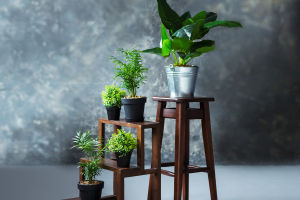We all love homes that feel fresh, inviting, and full of life. One of the easiest ways to achieve this is by adding indoor plants.
Plants not only act as natural decorations but also make spaces feel cozier, cleaner, and more dynamic. Today, we’re sharing a detailed guide to arranging indoor plants effectively, so every corner of your home looks intentional and beautiful.
High-Low Arrangement: Add Depth
When placing multiple plants, avoid lining them all at the same height—it looks flat and dull. Instead, create a high-low layout. Pair a tall plant, like a palm or fiddle-leaf fig, with a shorter one, such as a small cactus or fern. This contrast adds layers and visual interest.
Variation is key: even plants of similar heights benefit from slight differences. The goal is to create a rhythm in your display, making your room feel lively without overwhelming it.
The Triangle Principle: Balance Your Space
A simple design tip is using a triangle layout. Place a tall plant in one corner, a medium plant on a table, and a smaller one on a shelf. This creates a balanced, stable arrangement that naturally draws the eye around the room. Whether in the living room, dining area, or bedroom, this method makes your home feel harmonious and thoughtfully arranged.
Sparse Planting for Small Spaces
For compact rooms, avoid overly dense plants that can make the space feel cramped. Choose plants with lighter, airy foliage like Japanese umbrella trees, dracaenas, or peacock plants. Sparse arrangements give a sense of openness and comfort, making even small areas feel welcoming and airy.
Match Plant Size with Room Scale
Room size plays a crucial role in plant selection. Small spaces work best with compact plants or hanging baskets that save floor space. Large rooms allow for tall, dramatic plants that create a sense of grandeur. Matching plant size to room scale ensures the arrangement looks natural rather than crowded or tiny.
Consider Light and Placement
Different areas of your home receive varying levels of natural light. South- and east-facing rooms suit sun-loving plants, while north- or west-facing rooms benefit shade-tolerant species. Observing sunlight patterns and adjusting plant placement accordingly will help your greenery thrive and remain vibrant.
Seasonal Adjustments
Plants respond to seasonal changes in temperature and humidity. Spring is ideal for flowering plants like azaleas or camellias, while summer favors heat-tolerant options such as jasmine or crotons. Being aware of seasonal needs keeps your indoor plants healthy and visually appealing throughout the year.
Complement Your Style
Our homes should reflect personal taste. Whether we prefer bold, lush greenery or minimalistic arrangements, our choices should match our aesthetic. Combining style with practical placement principles ensures that our indoor plants enhance the overall decor rather than feeling out of place.
Tips for Specific Rooms
- Entryway: Often dimly lit, ideal for low-light tolerant plants or dried flowers.
- Living Room: Spacious areas can handle larger plants and fragrant flowers, adding vibrancy and energy.
- Dining Area: Keep plants neat, subtle, and lightly scented to maintain a pleasant mealtime atmosphere.
- Bedroom: Opt for small, low-odor plants like succulents, gardenias, or daffodils to create a calming environment.
- Study: Choose simple, elegant plants that add a touch of sophistication. A small bonsai or well-shaped potted plant enhances focus and decor simultaneously.
Bring Your Home to Life
Lykkers, arranging indoor plants isn’t just about filling empty corners—it’s about creating a home that feels alive, balanced, and welcoming. By using high-low layouts, triangle arrangements, and airy placements, and considering light, space, seasons, and personal style, we can turn every room into a thoughtfully designed, green oasis. Let’s have fun experimenting with indoor plants and watch our homes bloom with energy and charm!


